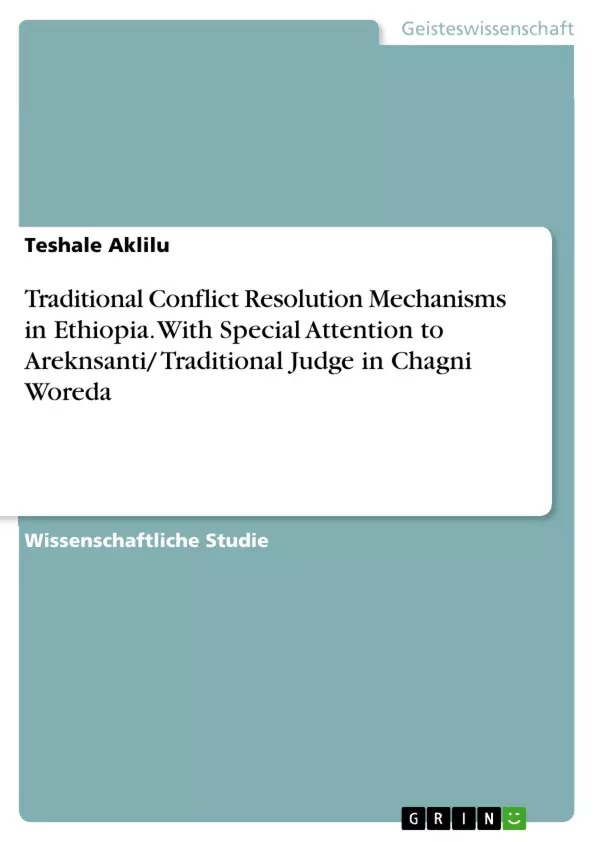This study reveals the role of Areknsanti as a traditional conflict resolution mechanism in handling conflicts in Chagni woreda in Awi Zone, Amhara National Regional State. Qualitative research methodology particularly and design were employed for it. It was found to be appropriate to assess the role of traditional institution of Arkeknsanti in handling conflicts in the study area. The collected data were analyzed through thematic analysis. The Researcher used representative sampling techniques. In addition to this, researcher used both primary and secondary sources. Conflict of the study area emanated from two categories of economic ones and social conflict on the other side.
In the world there are many conflict can arise in different group of society or the same group are known as intra or enter group conflict and it is the struggle over value or claims to status and scarce resource such as economy and political power. Almost all over the peoples of the world regardless of their location in time and space have their own methods to solve disputes and achieving resolution of their differences. Gulliver states that every society has its own mechanism of solving conflict. Conflict management refers to the long term management of intractable conflict. And label for the variety of ways by which people handle conflict standing up for what they consider to be right and against what they consider to be wrong. Conflict management is often considered to be distinct from conflict resolution. And it may occur between warring parties who contest an incompatibility. Nature of incompatibility can be territorial or governmental but warring party must be a government of a state or any opposition organization or alliance of organization that use armed force to promote its position in the incompatibility in an intrastate or interstate armed conflict.
Inhaltsverzeichnis
- Kapitel Eins: Einleitung
- 1.1 Hintergrund der Studie
- 1.2 Problemstellung
- 1.3 Forschungsfragen
- 1.4 Zielsetzung der Studie
- 1.4.1 Allgemeines Ziel
- 1.4.2 Spezifische Ziele
- 1.5 Bedeutung der Studie
- 1.6 Umfang der Studie
- 1.7 Beschreibung des Untersuchungsgebiets
- 1.7.1 Lage
- 1.7.2 Bevölkerung
- 1.7.3 Sozioökonomische Merkmale
- 1.7.4 Physische Merkmale
- 1.8 Definition der Begriffe
- Kapitel Zwei: Literaturübersicht
- 2.1 Konfliktbegriff
- 2.2 Konfliktquellen
- 2.3 Notwendigkeit der Konfliktlösung
- 2.4 Konfliktlösungsmethoden
Zielsetzung und Themenschwerpunkte
Diese Studie untersucht die Rolle traditioneller Konfliktlösungsmechanismen in Äthiopien, insbesondere die des Areknsanti (traditioneller Richter) in Chagni Woreda. Die Hauptziele sind die Analyse der Funktionsweise des Areknsanti, die Prüfung der Durchsetzbarkeit seiner Entscheidungen, die Untersuchung der Dynamik und Veränderungen des Prozesses sowie die Bewertung der Stärken, Schwächen und Herausforderungen dieser Institution.
- Traditionelle Konfliktlösung in Äthiopien
- Funktion und Rolle des Areknsanti
- Durchsetzbarkeit von Entscheidungen des Areknsanti
- Dynamik und Veränderungen des traditionellen Konfliktlösungsmechanismus
- Stärken, Schwächen und Herausforderungen des Areknsanti
Zusammenfassung der Kapitel
Kapitel Eins: Einleitung: Dieses einleitende Kapitel legt den Hintergrund der Studie dar, beschreibt die Problemstellung und formuliert die Forschungsfragen und Ziele. Es definiert den Untersuchungsraum Chagni Woreda, beschreibt dessen sozioökonomische und physische Merkmale und klärt wichtige Begriffe. Es dient als Grundlage für die darauf folgenden Kapitel, indem es den Rahmen und die methodischen Ansätze der Forschungsarbeit festlegt. Die Bedeutung der Studie für die Konfliktforschung und die Praxis der Konfliktlösung wird ebenfalls hervorgehoben.
Kapitel Zwei: Literaturübersicht: In diesem Kapitel werden relevante Theorien und Studien zum Thema Konflikt und Konfliktlösung vorgestellt. Es werden verschiedene Konfliktbegriffe, Konfliktquellen und -ursachen beleuchtet, um ein umfassendes Verständnis des Forschungsfeldes zu schaffen. Der Überblick über existierende Konfliktlösungsmethoden dient als Vergleichsrahmen für die Analyse des traditionellen Mechanismus des Areknsanti. Der Schwerpunkt liegt auf der Einordnung der Studie in den bestehenden Forschungsstand und der Herleitung der eigenen Forschungsfragen.
Schlüsselwörter
Areknsanti, Konflikt, Traditionelle Konfliktlösung, Äthiopien, Chagni Woreda, Konfliktlösungsmechanismen, Friedensförderung, Kultur, Tradition.
Häufig gestellte Fragen (FAQ) zur Studie: Traditionelle Konfliktlösung in Äthiopien
Was ist der Gegenstand der Studie?
Die Studie untersucht traditionelle Konfliktlösungsmechanismen in Äthiopien, speziell die Rolle des Areknsanti (traditioneller Richter) in Chagni Woreda. Analysiert werden die Funktionsweise des Areknsanti, die Durchsetzbarkeit seiner Entscheidungen, die Dynamik und Veränderungen des Prozesses sowie die Stärken, Schwächen und Herausforderungen dieser Institution.
Welche Ziele verfolgt die Studie?
Die Hauptziele sind die Analyse der Funktionsweise des Areknsanti, die Prüfung der Durchsetzbarkeit seiner Entscheidungen, die Untersuchung der Dynamik und Veränderungen des Prozesses sowie die Bewertung der Stärken, Schwächen und Herausforderungen dieser Institution. Die Studie möchte ein umfassendes Verständnis des traditionellen Konfliktlösungssystems in diesem Kontext liefern.
Welche Kapitel umfasst die Studie?
Die Studie besteht mindestens aus zwei Kapiteln: Kapitel Eins (Einleitung) und Kapitel Zwei (Literaturübersicht). Kapitel Eins legt den Hintergrund, die Problemstellung, Forschungsfragen und Ziele dar, beschreibt das Untersuchungsgebiet (Chagni Woreda) und definiert wichtige Begriffe. Kapitel Zwei präsentiert relevante Theorien und Studien zum Thema Konflikt und Konfliktlösung, beleuchtet verschiedene Konfliktbegriffe, Quellen und Ursachen und gibt einen Überblick über existierende Konfliktlösungsmethoden.
Wie ist der Aufbau des Inhaltsverzeichnisses?
Das Inhaltsverzeichnis beginnt mit einer Einleitung (Kapitel Eins), die verschiedene Unterkapitel umfasst, einschließlich Hintergrund, Problemstellung, Forschungsfragen, Zielsetzung, Bedeutung der Studie, Umfang der Studie und Beschreibung des Untersuchungsgebiets (inkl. Lage, Bevölkerung, sozioökonomische und physische Merkmale) sowie Begriffsbestimmungen. Kapitel Zwei befasst sich mit der Literaturübersicht, die wiederum Unterkapitel zu Konfliktbegriff, Konfliktquellen, Notwendigkeit der Konfliktlösung und Konfliktlösungsmethoden enthält.
Welche Schlüsselwörter sind relevant für die Studie?
Wichtige Schlüsselwörter sind: Areknsanti, Konflikt, Traditionelle Konfliktlösung, Äthiopien, Chagni Woreda, Konfliktlösungsmechanismen, Friedensförderung, Kultur, Tradition.
Welche Themenschwerpunkte werden behandelt?
Die Studie konzentriert sich auf die traditionelle Konfliktlösung in Äthiopien, die Funktion und Rolle des Areknsanti, die Durchsetzbarkeit seiner Entscheidungen, die Dynamik und Veränderungen des traditionellen Konfliktlösungsmechanismus sowie die Stärken, Schwächen und Herausforderungen des Areknsanti.
Was wird in der Zusammenfassung der Kapitel beschrieben?
Die Zusammenfassung beschreibt den Inhalt von Kapitel Eins (Einleitung) als Grundlage für die weitere Forschung und Kapitel Zwei (Literaturübersicht) als Einordnung der Studie in den bestehenden Forschungsstand und Herleitung der eigenen Forschungsfragen.
- Quote paper
- Teshale Aklilu (Author), 2012, Traditional Conflict Resolution Mechanisms in Ethiopia. With Special Attention to Areknsanti/ Traditional Judge in Chagni Woreda, Munich, GRIN Verlag, https://www.grin.com/document/1003119



